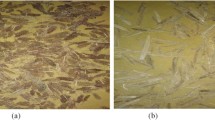Abstract
The study was undertaken to investigate the properties of cassava starch and gum arabic bonded briquettes from the sawdust of Azadirachta indica. The briquettes were produced using a Jack press at an average pressure of 10.7 kg·cm−2. The sawdust and binders were mixed at ratios of 100:15, 100:25, 100:35 and 100:45 in weight, respectively. The briquettes produced were subjected to physical and combustion tests. Both the physical and combustion properties of the briquettes vary with binder types and binder levels (p < 0.05). The result shows that briquettes bonded with starch gave better performance based on density of 0.546 g·cm−3, durability rating of 95.93%, heating value of 33.09 MJ·kg−1, percentage of fixed carbon of 84.70% and low ash and volatile matter of 3.35% and 11.95%, respectively, while briquette bonded with gum arabic has density of 0.425 g·cm−3, durability rating of 94.85%, heating value of 32.76 MJ·kg−1, percentage of fixed carbon of 87.30% and low ash and volatile matter of 4.45% and 8.75, respectively. Since the aim of briquetting is to produce briquette that will serve as a good source of fuel and support combustion, the best briquette was produced when the sawdust-starch ratio and sawdust-gum arabic ratio was 100:25 and 100:35, respectively.
Similar content being viewed by others
References
Akinbami JFK. 2001. Renewable energy resources and technologies in Nigeria: present situation, future prospects and policy framework. Mitigation and Adaptation Strategies for Global Change, 6: 155–181.
Ardayfio-Schandorf E. 1996. The fuelwood/energy crisis in Sub-Saharan Africa. In: George Benneh, William B. Morgan, and Juha I. Uitto (eds.), Sustaining the Future. Economic, Social, and Environmental Change in Sub-Saharan Africa. The United Nations University, ISBN: 0585229996, pp. 365, 380.
ASTM Standard E711-87. 2004. Standard Test Method for Gross Calorific Value of Refuse-Derived fuel by the Bomb Calorimeter. Annual Book of ASTM Standards, 11.04. ASTM International. http://www.astm.info/Standards/E711.htm.
Bailey RT, Blankenhorn PR. 1982. Calorific and porosity development in carbonized wood. Wood Science, 15(1): 19–28.
Bruhn HD, Zimmerman A and Niedermier RP. 1957. Developments in pelleting forage crops. Agricultural Engineering, 40: 204–207.
Dahlam J, Forst C. 2001. Technologies demonstrated at ECHO: Briquette presses for alternate fuel use. ECHO, 17391 Durrance Rd., North Ft. Myers FL 33917, USA.
Grover PD, Mishra SK. 1994. Development of an appropriate biomass briquetting technology suitable for production and use in developing countries. Energy for Sustainable Development, 1: 45–48.
Hakkila P, Parikka M. 2002. Fuel Resources from the forest. In: Richardson J, Bjorheden R, Hakkila P, Lowe AT and Smith CT (eds), Bioenergy from Sustainable Forestry: Guiding Principles and Practice. The Netherlands: Kluwer Academic Publishers, ISBN: 1402006764. pp. 19–48.
Himraj D. 1993. Fuel substitution in sub-Saharan Africa. Environmental Management, 17(3): 283–288
Husain Z, Zainac Z, Abdullah Z. 2002. Briquetting of palm fibre and shell from the processing of palm nuts to palm oil. Biomass and Bioenergy, 22: 505–509.
Ivanov IP, Sudakova IG, Kuznetsovv B. 2003. Manufacture of Briquetted and Granulated Fuels from Lignite with Biobinders and Heated Die. Chemistry for Sustainable Development, 11: 847–852p.
Kituyi E, Marufu L, Wandiga S, Jumba I, Andreae M, Helas G. 2001. Biofuel availability and domestic use patterns in Kenya. Biomass and Bioenergy, 20: 71–82.
Stout BA, Best G. 2001. Effective energy use and climate change: needs of rural areas in developing countries. Agricultural Engineering International: the CIGR E-Journal of Scientific Research and Development. 3: 19p.
Suparin C, Suwit S, Prattana K., 2008. Development of fuel briquettes from biomass-lignite blends. Chiang. Mai. J. Sci., 35(1): 43–50
Wilaipon P. 2007. Physical characteristics of maize cob briquette under moderate die pressure. Am. J. App. Sci., 4: 995–998.
Wilaipon P. 2008. Density Equation of Bio-Coal Briquettes and Quantity of Maize Cob in Phitsanulok, Thailand. Am. J. App. Sci., 5(12): 1808–1811.
Author information
Authors and Affiliations
Corresponding author
Rights and permissions
About this article
Cite this article
Sotannde, O.A., Oluyege, A.O. & Abah, G.B. Physical and combustion properties of briquettes from sawdust of Azadirachta indica . Journal of Forestry Research 21, 63–67 (2010). https://doi.org/10.1007/s11676-010-0010-6
Received:
Accepted:
Published:
Issue Date:
DOI: https://doi.org/10.1007/s11676-010-0010-6




